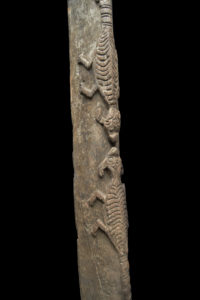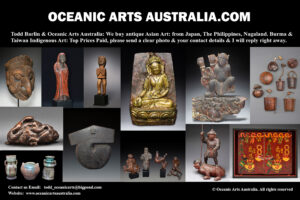A Rare & Beautiful Chief’s House Lintel Timor Island Indonesia 19th Century
| Collection No. | TB-3682 |
|---|---|
| Size | Height 215cm |
A Rare & Beautiful Chief’s House Lintel Timor Island Indonesia 19th Century
This finely carved Chief’s House Lintel is from the eastern half of the island of Timor now a newly independent country. The Lintel is dating from the late 19th century, the carving was a horizontal ornament under the front gable of one of the amazing architectural raised houses with peaked roofs. The main design is four large lizard figures in high relief with scroll-like textile-type designs on either end. The Lizard in Timor Art is an ancient motif that appears in cave paintings and early woven textiles & carved doors. There is a spectacularly carved door with these types lizard carvings in the Yale University Museum collection online and a very similar Lintel to this in the Musee du Quai Branly Museum in Paris France
The Lizard is an important totemic clan animal that links the people with their ancestors
In the book “Traditional Art in Timorese Princedoms,” in Eyes of the Ancestors: The Arts of Island Southeast Asia at the Dallas Museum of Art, by Nico de Jonge in collaboration with Steven Alpert. They state
” Houses that were spiritually connected with the founding ancestors of a clan or lineage—the so-called houses of origin— were generally beautifully decorated. Within a clan, these named dwellings were ordered in a hierarchical way and were of great significance to its members. They represented the visible symbol of a group and, more important, functioned as the connection between the living and their ancestors; they and their annexes were ritual centres.
Throughout Timor, the architecture and decoration of a house of origin had its own specific character. The decoration would often be aimed at propagating the status of an individual group. An example of this can be found in gable finials in the shape of buffalo horns; owning buffalo was an essential indicator of status on Timor. Furthermore, the main posts, joists, and walls of a house were frequently adorned with depictions of totemic animals and various geometric forms. The splendidly ornamented door panels found in the Tetun residences of North Belu have become highly renowned.
In pre-colonial times, a house of origin was often part of a “village of origin,” a cluster of family residences. These hamlets were usually located on a hilltop that was easy to defend; conflicts between princedoms—especially over (alleged) cattle theft and claims on sandalwood trees and trees with beehives—were once common¬place. In the vicinity of an important house of origin (such as the eldest house of a clan), there would often be a connected small sacrificial temple, where the graves of esteemed ancestors, including stone platforms with altars and pole sculptures of the clan founders of the Aitos were located. These Aitos Ancestor Figures, in fact, constituted the only category of ancestor statues on Timor. ”
If anyone can help further with more information about this type of East Timor Architectural carved Lintel I would be more grateful to hear from you with any information or photos relating to carved Lintels in traditional Timor Architectural
Provenance: Daeng Iskandar Collection Bali & The Todd Barlin Private Collection of Indonesian & SE Asian & New Guinea Art
INQUIRE HERE
To see many more rare items and the finest masterpieces, please make an appointment with us to visit the gallery.
For all inquiries, please contact us.
















